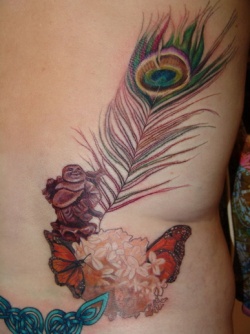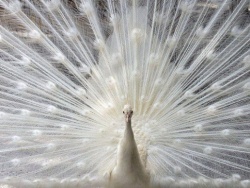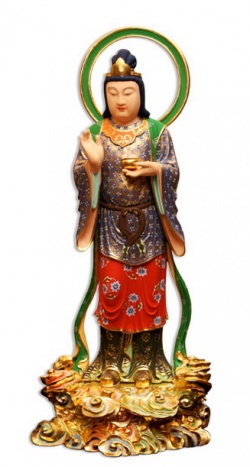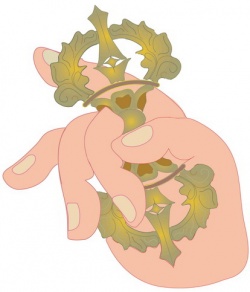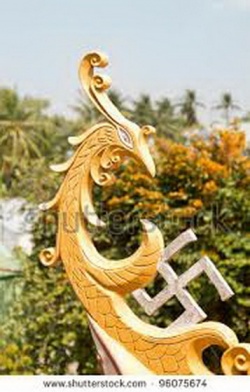Difference between revisions of "What Does a Peacock Feather Symbolize"
| Line 1: | Line 1: | ||
[[File:Traveli_rge.jpg|thumb|250px|]] | [[File:Traveli_rge.jpg|thumb|250px|]] | ||
| − | By Pragya T | + | By [[Pragya]] T |
[[File:Peacock-70 25.jpg|thumb|250px|]] | [[File:Peacock-70 25.jpg|thumb|250px|]] | ||
The [[peacock]] is a [[symbol]] of [[immortality]] because the ancients believed that the [[peacock]] had flesh that did not [[decay]] after [[death]]. As such, early {{Wiki|Christian}} paintings and mosaics use [[peacock]] [[imagery]], and [[peacock]] feathers can be used during the Easter season as {{Wiki|church}} decorations. This [[symbol]] of [[immortality]] is also directly linked to {{Wiki|Christ}}. The [[peacock]] naturally replaces his feathers annually; as such, the [[peacock]] is also a [[symbol]] of renewal. In {{Wiki|ancient Greece}}, the [[peacock]] was the {{Wiki|patron}} {{Wiki|bird}} of the [[Goddess]] Hera. According to [[myth]], she placed '[[eyes]]' on its feathers, [[symbolizing]] {{Wiki|all-seeing}} [[knowledge]] and the [[wisdom]] of the [[heavens]]. | The [[peacock]] is a [[symbol]] of [[immortality]] because the ancients believed that the [[peacock]] had flesh that did not [[decay]] after [[death]]. As such, early {{Wiki|Christian}} paintings and mosaics use [[peacock]] [[imagery]], and [[peacock]] feathers can be used during the Easter season as {{Wiki|church}} decorations. This [[symbol]] of [[immortality]] is also directly linked to {{Wiki|Christ}}. The [[peacock]] naturally replaces his feathers annually; as such, the [[peacock]] is also a [[symbol]] of renewal. In {{Wiki|ancient Greece}}, the [[peacock]] was the {{Wiki|patron}} {{Wiki|bird}} of the [[Goddess]] Hera. According to [[myth]], she placed '[[eyes]]' on its feathers, [[symbolizing]] {{Wiki|all-seeing}} [[knowledge]] and the [[wisdom]] of the [[heavens]]. | ||
[[File:Raksasis-Kutadanti.jpg|thumb|250px|]] | [[File:Raksasis-Kutadanti.jpg|thumb|250px|]] | ||
| − | The [[peacock]] is a possessor of some of the most admired [[human]] {{Wiki|characteristics}}, and is a [[symbol]] of integrity and the [[beauty]] we can achieve when we endeavor to show our true colors. | + | The [[peacock]] is a possessor of some of the most admired [[human]] {{Wiki|characteristics}}, and is a [[symbol]] of [[integrity]] and the [[beauty]] we can achieve when we endeavor to show our true colors. |
[[File:Käsi-V a.jpg|thumb|250px|]] | [[File:Käsi-V a.jpg|thumb|250px|]] | ||
The [[peacock]], which is the national {{Wiki|bird}} of [[India]], is known for its [[beauty]] and grace. It is a [[symbol]] of [[beauty]], {{Wiki|prosperity}}, royalty, [[love]], [[compassion]], [[soul]] and [[peace]]. It is considered [[sacred]] in [[India]] and [[China]]. In [[Buddhism]] [[peacocks]] [[symbolize]] [[purity]] and their feathers are used for [[Buddhist]] [[purification]] {{Wiki|ceremonies}}. [[Peacock]] feathers have been used for [[healing]] for tens of thousands of years in every {{Wiki|culture}} throughout [[time]]. They are said to carry [[Spiritual]] [[healing]] [[energy]] that can be used to assist [[people]] seeking [[balance]] and [[harmony]] in their [[lives]]. In [[Hinduism]] the [[peacock]] is associated with [[Lakshmi]], who is a [[deity]] representing [[benevolence]], [[patience]], [[kindness]], [[compassion]] and good [[luck]]. | The [[peacock]], which is the national {{Wiki|bird}} of [[India]], is known for its [[beauty]] and grace. It is a [[symbol]] of [[beauty]], {{Wiki|prosperity}}, royalty, [[love]], [[compassion]], [[soul]] and [[peace]]. It is considered [[sacred]] in [[India]] and [[China]]. In [[Buddhism]] [[peacocks]] [[symbolize]] [[purity]] and their feathers are used for [[Buddhist]] [[purification]] {{Wiki|ceremonies}}. [[Peacock]] feathers have been used for [[healing]] for tens of thousands of years in every {{Wiki|culture}} throughout [[time]]. They are said to carry [[Spiritual]] [[healing]] [[energy]] that can be used to assist [[people]] seeking [[balance]] and [[harmony]] in their [[lives]]. In [[Hinduism]] the [[peacock]] is associated with [[Lakshmi]], who is a [[deity]] representing [[benevolence]], [[patience]], [[kindness]], [[compassion]] and good [[luck]]. | ||
| Line 18: | Line 18: | ||
A white [[peacock]] is a [[symbol]] of [[nirvana]] in [[Buddhism]] & {{Wiki|vedic}} [[religions]]. | A white [[peacock]] is a [[symbol]] of [[nirvana]] in [[Buddhism]] & {{Wiki|vedic}} [[religions]]. | ||
{{NewSourceBreak}} | {{NewSourceBreak}} | ||
| − | [[Peacock]] is seen in many parts of the [[world]]. But, it is native to {{Wiki|Pakistan}}, [[India]], {{Wiki|Bangladesh}}, [[Sri Lanka]] and {{Wiki|western}} [[China]]. [[Peacocks]] are magnificent birds which have multicolored stunning tail feathers. Only the {{Wiki|male}} birds of this species have these beautiful multicolored tail feathers. A {{Wiki|male}} [[peacock]] displays its magnificent tail feathers in an attempt to attract the {{Wiki|female}}. [[Peacocks]] due to their beautiful looking feathers and due to their [[habits]] are associated with different [[symbolic]] meanings. Here are various [[peacock]] and [[peacock]] feather [[symbolic]] meanings. | + | [[Peacock]] is seen in many parts of the [[world]]. But, it is native to {{Wiki|Pakistan}}, [[India]], {{Wiki|Bangladesh}}, [[Sri Lanka]] and {{Wiki|western}} [[China]]. [[Peacocks]] are magnificent birds which have multicolored stunning tail feathers. Only the {{Wiki|male}} birds of this {{Wiki|species}} have these beautiful multicolored tail feathers. A {{Wiki|male}} [[peacock]] displays its magnificent tail feathers in an attempt to attract the {{Wiki|female}}. [[Peacocks]] due to their beautiful looking feathers and due to their [[habits]] are associated with different [[symbolic]] meanings. Here are various [[peacock]] and [[peacock]] feather [[symbolic]] meanings. |
===[[Peacock]] & [[Peacock]] Feather Meaning=== | ===[[Peacock]] & [[Peacock]] Feather Meaning=== | ||
| Line 30: | Line 30: | ||
In [[Buddhism]], [[peacock]] feathers are associated with [[openness]], as they tend to display all their feathers when they spread their tail. [[Peacocks]] also eat {{Wiki|poisonous}} [[plants]], which [[symbolizes]] that they have the ability to thrive in the face of [[suffering]]. | In [[Buddhism]], [[peacock]] feathers are associated with [[openness]], as they tend to display all their feathers when they spread their tail. [[Peacocks]] also eat {{Wiki|poisonous}} [[plants]], which [[symbolizes]] that they have the ability to thrive in the face of [[suffering]]. | ||
| − | In [[Christianity]], the [[Peacock]] [[symbolizes]] {{Wiki|resurrection}}, [[immortality]], renewal associated with the [[spiritual]] teachings of [[Christianity]]. In [[Christianity]], [[peacock]] [[symbolizes]] an all [[seeing]] {{Wiki|church}}. In {{Wiki|Persia}} and {{Wiki|Babylonia}}, [[peacock]] is seen as the guardian to royalty, and is often engraved on the thrones of royals. According to a {{Wiki|Muslim}} legend, this {{Wiki|bird}} of stunning [[beauty]] is used as a [[symbol]] in [[temples]], {{Wiki|royal}} garden and at the gates of [[Paradise]]. | + | In [[Christianity]], the [[Peacock]] [[symbolizes]] {{Wiki|resurrection}}, [[immortality]], renewal associated with the [[spiritual]] teachings of [[Christianity]]. In [[Christianity]], [[peacock]] [[symbolizes]] an all [[seeing]] {{Wiki|church}}. In {{Wiki|Persia}} and {{Wiki|Babylonia}}, [[peacock]] is seen as the guardian to royalty, and is often engraved on the thrones of royals. According to a {{Wiki|Muslim}} legend, this {{Wiki|bird}} of stunning [[beauty]] is used as a [[symbol]] in [[temples]], {{Wiki|royal}} [[garden]] and at the gates of [[Paradise]]. |
[[Peacock]] feathers were worn by {{Wiki|Mongol}} {{Wiki|warriors}}, due to which in Eastern {{Wiki|Europe}}, [[peacock]] feathers are considered as a [[symbol]] of bad [[luck]]. As [[peacock]] is considered to be a [[seer]] of everything due to its multiple [[eyes]], it is considered to be a [[symbol]] of bad [[luck]], and so it is never allowed inside a [[home]]. There is a {{Wiki|superstitious}} [[belief]], which states that a [[person]] [[sleeping]] on a bed which has [[peacock]] feathers on it, will bring [[death]] to the sleeper. [[Peacocks]] are also considered as vain and [[foolish]] birds. They tend to display their feathers as a sign of vanity. | [[Peacock]] feathers were worn by {{Wiki|Mongol}} {{Wiki|warriors}}, due to which in Eastern {{Wiki|Europe}}, [[peacock]] feathers are considered as a [[symbol]] of bad [[luck]]. As [[peacock]] is considered to be a [[seer]] of everything due to its multiple [[eyes]], it is considered to be a [[symbol]] of bad [[luck]], and so it is never allowed inside a [[home]]. There is a {{Wiki|superstitious}} [[belief]], which states that a [[person]] [[sleeping]] on a bed which has [[peacock]] feathers on it, will bring [[death]] to the sleeper. [[Peacocks]] are also considered as vain and [[foolish]] birds. They tend to display their feathers as a sign of vanity. | ||
| Line 36: | Line 36: | ||
[[Peacocks]] are very protective about their young ones, and so many times women get a [[peacock]] feather tattoo to [[symbolize]] this. One more [[myth]] states that the [[peacock]] is a slayer of serpents, and it can [[transform]] the venom of {{Wiki|snakes}} into {{Wiki|solar}} iridescence, which is seen in its feathers. | [[Peacocks]] are very protective about their young ones, and so many times women get a [[peacock]] feather tattoo to [[symbolize]] this. One more [[myth]] states that the [[peacock]] is a slayer of serpents, and it can [[transform]] the venom of {{Wiki|snakes}} into {{Wiki|solar}} iridescence, which is seen in its feathers. | ||
| − | These were the various [[peacock]] and [[peacock]] feathers [[symbol]] meanings. So, all in all [[peacock]] and its feathers [[symbolizes]] vanity, {{Wiki|pride}}, royalty, [[spirituality]], [[kindness]], [[love]], [[compassion]], [[good will]], bad [[luck]], protectiveness, glory, [[beauty]], [[life]], health, radiance, {{Wiki|resurrection}}, renewal, {{Wiki|stimulation}} and [[life]]. | + | These were the various [[peacock]] and [[peacock]] feathers [[symbol]] meanings. So, all in all [[peacock]] and its feathers [[symbolizes]] vanity, {{Wiki|pride}}, royalty, [[spirituality]], [[kindness]], [[love]], [[compassion]], [[good will]], bad [[luck]], protectiveness, glory, [[beauty]], [[life]], [[health]], radiance, {{Wiki|resurrection}}, renewal, {{Wiki|stimulation}} and [[life]]. |
{{R}} | {{R}} | ||
[http://www.buzzle.com/articles/what-does-a-peacock-feather-symbolize.html www.buzzle.com] | [http://www.buzzle.com/articles/what-does-a-peacock-feather-symbolize.html www.buzzle.com] | ||
| Line 45: | Line 45: | ||
Instead think of what William Blake wrote, “The {{Wiki|pride}} of the [[peacock]] is the glory of [[God]].” | Instead think of what William Blake wrote, “The {{Wiki|pride}} of the [[peacock]] is the glory of [[God]].” | ||
| − | Due to their ability to fly, birds have been [[perceived]] as [[sacred]] emissaries since {{Wiki|ancient}} times. As a result, they are immortalized in [[art]], [[spiritual]] writings, {{Wiki|legends}}, and songs. Even in the twenty-first century man still holds a [[sense]] of awe for birds. | + | Due to their ability to fly, birds have been [[perceived]] as [[sacred]] emissaries since {{Wiki|ancient}} times. As a result, they are immortalized in [[art]], [[spiritual]] writings, {{Wiki|legends}}, and [[songs]]. Even in the twenty-first century man still holds a [[sense]] of awe for birds. |
The use of the [[peacock]] as a [[mystical]] [[symbol]] spans antiquity. The {{Wiki|ancient}} {{Wiki|Greco-Roman}} [[religions]] held the {{Wiki|bird}} [[sacred]] to Hera, who was [[Wikipedia:Queen consort|queen]] of the [[gods]]. | The use of the [[peacock]] as a [[mystical]] [[symbol]] spans antiquity. The {{Wiki|ancient}} {{Wiki|Greco-Roman}} [[religions]] held the {{Wiki|bird}} [[sacred]] to Hera, who was [[Wikipedia:Queen consort|queen]] of the [[gods]]. | ||
| Line 59: | Line 59: | ||
They have also been domesticated pets for over 3,000 years. From the beginning they have been seen as {{Wiki|superior}} guardians for [[temples]] and {{Wiki|palaces}}. This is because they let out a shrill warning cry when strangers approach. This skill has rightly earned the [[peacock]] the reputation as a [[protector]]. | They have also been domesticated pets for over 3,000 years. From the beginning they have been seen as {{Wiki|superior}} guardians for [[temples]] and {{Wiki|palaces}}. This is because they let out a shrill warning cry when strangers approach. This skill has rightly earned the [[peacock]] the reputation as a [[protector]]. | ||
| − | They are like a [[celestial]] [[vision]], bringing a [[sense]] of [[joy]] to our [[lives]]. Just looking at the [[peacock]] lifts your [[spirits]]. They bestow a renewed [[sense]] of wonder and [[appreciation]] for the [[beauty]] of [[God’s]] creations. | + | They are like a [[celestial]] [[vision]], bringing a [[sense]] of [[joy]] to our [[lives]]. Just looking at the [[peacock]] lifts your [[spirits]]. They bestow a renewed [[sense]] of [[wonder]] and [[appreciation]] for the [[beauty]] of [[God’s]] creations. |
[[Peacocks]] strike a chord within to take more [[pure]] [[joy]] in [[life]], just by being who we are. To be proud of whom we are and strut our stuff, not to “keep our [[light]] under a bushel”. | [[Peacocks]] strike a chord within to take more [[pure]] [[joy]] in [[life]], just by being who we are. To be proud of whom we are and strut our stuff, not to “keep our [[light]] under a bushel”. | ||
| Line 65: | Line 65: | ||
Their fan of a thousand [[eyes]] evokes the [[feeling]] of being under the watchful [[Eye]] of [[God]], All [[Seeing]], and All Powerful. | Their fan of a thousand [[eyes]] evokes the [[feeling]] of being under the watchful [[Eye]] of [[God]], All [[Seeing]], and All Powerful. | ||
| − | While it is considered extremely bad [[luck]] to display any part of a [[dead]] [[animal]] in one’s [[space]], please note that the [[peacock]] is not killed to collect their [[luminous]] plumage! After the mating season the {{Wiki|male}} sheds all his glorious feathers. [[People]] who sell the feathers [[do not kill]] the birds. They collect them for sale after each season. Unlike many other species of birds, the fowl was not hurt in the [[attainment]] of the feathers. He joyfully discards the plumage after their “[[magic]]” has gotten him the [[love]] of his chosen peahen. | + | While it is considered extremely bad [[luck]] to display any part of a [[dead]] [[animal]] in one’s [[space]], please note that the [[peacock]] is not killed to collect their [[luminous]] plumage! After the mating season the {{Wiki|male}} sheds all his glorious feathers. [[People]] who sell the feathers [[do not kill]] the birds. They collect them for sale after each season. Unlike many other {{Wiki|species}} of birds, the fowl was not {{Wiki|hurt}} in the [[attainment]] of the feathers. He joyfully discards the plumage after their “[[magic]]” has gotten him the [[love]] of his chosen peahen. |
| − | The power of the [[peacock]] can be used quite successfully in many {{Wiki|feng shui}} cures. Since birds are of the “[[fire]]” [[element]], displaying images or [[peacock]] feathers in the [[Fame]] Gua is exceptionally [[lucky]]. This should boost your [[recognition]] greatly. You will be seen as a [[person]] of much integrity and grace. You can achieve much [[fame]] and others will appreciate your talents. Being under the [[protection]] of the “All [[Seeing]] [[Eye]]”, you will be kept free of [[jealousy]] and scandal. | + | The power of the [[peacock]] can be used quite successfully in many {{Wiki|feng shui}} cures. Since birds are of the “[[fire]]” [[element]], displaying images or [[peacock]] feathers in the [[Fame]] Gua is exceptionally [[lucky]]. This should boost your [[recognition]] greatly. You will be seen as a [[person]] of much [[integrity]] and grace. You can achieve much [[fame]] and others will appreciate your talents. Being under the [[protection]] of the “All [[Seeing]] [[Eye]]”, you will be kept free of [[jealousy]] and scandal. |
| − | The number nine is associated with the [[Fame]] area. Therefore if you place actual feathers here it is best to use nine feathers in the display. This will reap maximum good [[fortune]]. Put them in a red or green [[vase]]. | + | The number nine is associated with the [[Fame]] area. Therefore if you place actual feathers here it is best to use nine feathers in the display. This will reap maximum good [[fortune]]. Put them in a [[red]] or [[green]] [[vase]]. |
The Relationship gua is of the [[Earth element]]. Therefore the [[peacock]] can bestow [[blessings]] upon it. Things in two should be utilized in this area. If you’re planning on using a print, there are some important guidelines to follow. First make sure the two birds are looking at each other. If they’re looking in different [[directions]] there will only be disagreements in the relationship. Also make sure you have a [[peacock]] and a peahen in the print. Remember what you see is what you get in {{Wiki|feng shui}}. Two birds of the same {{Wiki|sex}} will bring you a same {{Wiki|sex}} lover. I have recommended this cure to many of my {{Wiki|gay}} clients. If you [[desire]] a male-female relationship, the birds must be {{Wiki|male}} and {{Wiki|female}}. Many prints only have the {{Wiki|males}} in them because the peahen is not as colorfully attired as the [[peacock]]. Shop with care and [[attention]]. | The Relationship gua is of the [[Earth element]]. Therefore the [[peacock]] can bestow [[blessings]] upon it. Things in two should be utilized in this area. If you’re planning on using a print, there are some important guidelines to follow. First make sure the two birds are looking at each other. If they’re looking in different [[directions]] there will only be disagreements in the relationship. Also make sure you have a [[peacock]] and a peahen in the print. Remember what you see is what you get in {{Wiki|feng shui}}. Two birds of the same {{Wiki|sex}} will bring you a same {{Wiki|sex}} lover. I have recommended this cure to many of my {{Wiki|gay}} clients. If you [[desire]] a male-female relationship, the birds must be {{Wiki|male}} and {{Wiki|female}}. Many prints only have the {{Wiki|males}} in them because the peahen is not as colorfully attired as the [[peacock]]. Shop with care and [[attention]]. | ||
Revision as of 07:19, 19 November 2015
By Pragya T
The peacock is a symbol of immortality because the ancients believed that the peacock had flesh that did not decay after death. As such, early Christian paintings and mosaics use peacock imagery, and peacock feathers can be used during the Easter season as church decorations. This symbol of immortality is also directly linked to Christ. The peacock naturally replaces his feathers annually; as such, the peacock is also a symbol of renewal. In ancient Greece, the peacock was the patron bird of the Goddess Hera. According to myth, she placed 'eyes' on its feathers, symbolizing all-seeing knowledge and the wisdom of the heavens.
The peacock is a possessor of some of the most admired human characteristics, and is a symbol of integrity and the beauty we can achieve when we endeavor to show our true colors.
The peacock, which is the national bird of India, is known for its beauty and grace. It is a symbol of beauty, prosperity, royalty, love, compassion, soul and peace. It is considered sacred in India and China. In Buddhism peacocks symbolize purity and their feathers are used for Buddhist purification ceremonies. Peacock feathers have been used for healing for tens of thousands of years in every culture throughout time. They are said to carry Spiritual healing energy that can be used to assist people seeking balance and harmony in their lives. In Hinduism the peacock is associated with Lakshmi, who is a deity representing benevolence, patience, kindness, compassion and good luck.
I also checked to see what means if you dream about peacocks, and found that dreaming about them may mean that our hard work is paying off, that we're gaining confidence, and/or that recognition in the offing.
I had no idea that there was so much symbolism and meaning surrounding peacocks, and I’m thinking that being drawn to them might well be a message from our Guides regarding the path we’re on and what we’re currently doing with our lives.
I’m going to end this column with an excerpt from fascinating story about peacocks that caught my attention—it was written by Lori Phillips of Bellaonline.com: ‘Flannery O'Connor, the great southern gothic writer, was a big fan of peacocks. Raising peafowl was a hobby of hers…A literature professor of mine theorized that the reason O'Connor was so drawn to the peacock was because of its dichotomy. On the one hand, the peacock is this beautiful bird, with connections to the divine. On the other, the peacock can be a terribly, terribly obnoxious bird - they emit horrible screeches and can be awfully aggressive. My professor theorized that the peacock seemed to O'Connor a perfect symbol of humanity itself.
A white peacock is a symbol of nirvana in Buddhism & vedic religions.
Peacock is seen in many parts of the world. But, it is native to Pakistan, India, Bangladesh, Sri Lanka and western China. Peacocks are magnificent birds which have multicolored stunning tail feathers. Only the male birds of this species have these beautiful multicolored tail feathers. A male peacock displays its magnificent tail feathers in an attempt to attract the female. Peacocks due to their beautiful looking feathers and due to their habits are associated with different symbolic meanings. Here are various peacock and peacock feather symbolic meanings.
Peacock & Peacock Feather Meaning
In Greek mythology, the peacock was associated with Hera. Hera created the Peacock from Argus who had hundred eyes. Hence, the tail feathers of peacock symbolize the vault of heaven and the eyes of the stars. This symbolizes all seeing knowledge. In Roman Empire, peacocks were Juno's birds and on the coins they symbolized the females of the ruling houses, which were the lineage princesses.
In Hindu mythology, the peacock is associated with the goddesses Lakshmi. This deity represents fortune, compassion, kindness and patience. Hence, peacock feathers are also used to symbolize these qualities.
In Asian spirituality, peacock is associated with Kwan-yin. Kwan-yin represents qualities like compassion, watchfulness, love, compassion and goodwill. Legend says that Kwan-yin remained a mortal even though she could be immortal. She remained a mortal, to aid humanity in their spiritual growth.
In Buddhism, peacock feathers are associated with openness, as they tend to display all their feathers when they spread their tail. Peacocks also eat poisonous plants, which symbolizes that they have the ability to thrive in the face of suffering.
In Christianity, the Peacock symbolizes resurrection, immortality, renewal associated with the spiritual teachings of Christianity. In Christianity, peacock symbolizes an all seeing church. In Persia and Babylonia, peacock is seen as the guardian to royalty, and is often engraved on the thrones of royals. According to a Muslim legend, this bird of stunning beauty is used as a symbol in temples, royal garden and at the gates of Paradise.
Peacock feathers were worn by Mongol warriors, due to which in Eastern Europe, peacock feathers are considered as a symbol of bad luck. As peacock is considered to be a seer of everything due to its multiple eyes, it is considered to be a symbol of bad luck, and so it is never allowed inside a home. There is a superstitious belief, which states that a person sleeping on a bed which has peacock feathers on it, will bring death to the sleeper. Peacocks are also considered as vain and foolish birds. They tend to display their feathers as a sign of vanity.
Peacocks are very protective about their young ones, and so many times women get a peacock feather tattoo to symbolize this. One more myth states that the peacock is a slayer of serpents, and it can transform the venom of snakes into solar iridescence, which is seen in its feathers.
These were the various peacock and peacock feathers symbol meanings. So, all in all peacock and its feathers symbolizes vanity, pride, royalty, spirituality, kindness, love, compassion, good will, bad luck, protectiveness, glory, beauty, life, health, radiance, resurrection, renewal, stimulation and life.
Source
Yes, there are some negative associations and sayings attached to this beautiful creature. “Proud as a peacock” is one. Also the common description of a vain person as a peacock is another. But do not allow them to keep you from incorporating the potent image of the peacock into your life.
Instead think of what William Blake wrote, “The pride of the peacock is the glory of God.”
Due to their ability to fly, birds have been perceived as sacred emissaries since ancient times. As a result, they are immortalized in art, spiritual writings, legends, and songs. Even in the twenty-first century man still holds a sense of awe for birds.
The use of the peacock as a mystical symbol spans antiquity. The ancient Greco-Roman religions held the bird sacred to Hera, who was queen of the gods.
They are also held sacred to Kuan Yin, the Buddhist saint of Mercy and Compassion. There is also a Buddhist cleansing ritual where three peacock feathers are burnt as offerings.
In Hinduism the deity Lakshmi, who represents patience, benevolence and good luck is associated with the peacock. In fact, even today the peacock is India’s official national bird.
In Santeria the peacock is sacred to two major female orishas. One, Yemaya is Queen of the Seven Seas, the home and protector of women. The other Oshun is the goddess of love and money. Adorn their altars or yourself in their name with peacock feathers. Then watch the blessings come flying in.
Found among many paintings and mosaics in the Catacombs of Rome, the peacock was used as an early symbol for Christ’s Resurrection. This is due to the ancients believing the flesh of the peacock does not decay. The white peacock has the special honor of representing the Christ Consciousness.
They have also been domesticated pets for over 3,000 years. From the beginning they have been seen as superior guardians for temples and palaces. This is because they let out a shrill warning cry when strangers approach. This skill has rightly earned the peacock the reputation as a protector.
They are like a celestial vision, bringing a sense of joy to our lives. Just looking at the peacock lifts your spirits. They bestow a renewed sense of wonder and appreciation for the beauty of God’s creations.
Peacocks strike a chord within to take more pure joy in life, just by being who we are. To be proud of whom we are and strut our stuff, not to “keep our light under a bushel”.
Their fan of a thousand eyes evokes the feeling of being under the watchful Eye of God, All Seeing, and All Powerful.
While it is considered extremely bad luck to display any part of a dead animal in one’s space, please note that the peacock is not killed to collect their luminous plumage! After the mating season the male sheds all his glorious feathers. People who sell the feathers do not kill the birds. They collect them for sale after each season. Unlike many other species of birds, the fowl was not hurt in the attainment of the feathers. He joyfully discards the plumage after their “magic” has gotten him the love of his chosen peahen.
The power of the peacock can be used quite successfully in many feng shui cures. Since birds are of the “fire” element, displaying images or peacock feathers in the Fame Gua is exceptionally lucky. This should boost your recognition greatly. You will be seen as a person of much integrity and grace. You can achieve much fame and others will appreciate your talents. Being under the protection of the “All Seeing Eye”, you will be kept free of jealousy and scandal.
The number nine is associated with the Fame area. Therefore if you place actual feathers here it is best to use nine feathers in the display. This will reap maximum good fortune. Put them in a red or green vase.
The Relationship gua is of the Earth element. Therefore the peacock can bestow blessings upon it. Things in two should be utilized in this area. If you’re planning on using a print, there are some important guidelines to follow. First make sure the two birds are looking at each other. If they’re looking in different directions there will only be disagreements in the relationship. Also make sure you have a peacock and a peahen in the print. Remember what you see is what you get in feng shui. Two birds of the same sex will bring you a same sex lover. I have recommended this cure to many of my gay clients. If you desire a male-female relationship, the birds must be male and female. Many prints only have the males in them because the peahen is not as colorfully attired as the peacock. Shop with care and attention.
We absorb and eventually become the energies surrounding us. Incorporating the image of the peacock in dress, decoration and art can uplift our spirits to the heavens, place us under protection of celestial deities and bring us much prominence and romance. Try some Peacock Power to enrich your life. </poem>
